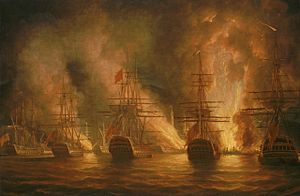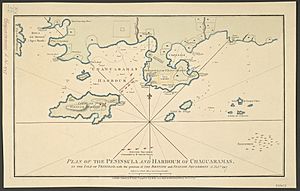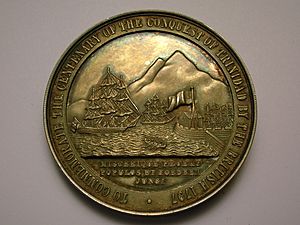Invasion of Trinidad (1797) facts for kids
Quick facts for kids Capture of Trinidad |
|||||||||
|---|---|---|---|---|---|---|---|---|---|
| Part of the French Revolutionary Wars | |||||||||
 The Capture of Trinidad, 17 February 1797 by Nicholas Pocock |
|||||||||
|
|||||||||
| Belligerents | |||||||||
| Commanders and leaders | |||||||||
| Strength | |||||||||
| 10,000 soldiers & marines 18 ships: 9 ships of line, 3 frigates, 3 corvettes, 3 sloops |
2100 soldiers, seamen & marines (including ~700 sick) 4 ships of line 1 frigate |
||||||||
| Casualties and losses | |||||||||
| 1 killed | 2,100 captured (~700 sick) 4 ships of the line scuttled 1 ship of the line captured |
||||||||
In February 1797, a large fleet of 18 British warships arrived at the island of Trinidad. They were led by Sir Ralph Abercromby. Within a few days, the Spanish Governor, Don José María Chacón, surrendered the island to the British.
This event happened because of a treaty signed in 1796. Spain and France became allies. This meant Spain was now an enemy of Great Britain. In response, Britain sent its navy to the Caribbean. Their goal was to take over Trinidad and Puerto Rico. They succeeded in taking Trinidad, but they were stopped in Puerto Rico.
Contents
Why Did Britain Invade Trinidad?
Before 1796, Spain and Great Britain were allies. But Spain lost a war against France in 1795. This led to a peace treaty. The next year, France and Spain signed an agreement to become allies. This made Spain an enemy of Great Britain.
British forces were already active in the Caribbean. They had taken French colonies like Saint Lucia. They also captured Dutch colonies in South America, such as Demerara and Essequibo. With Spain now at war with Britain, General Ralph Abercromby decided to attack Spain's colonies.
Trinidad was his first target. It was close to Tobago, which Britain had already captured. Trinidad had been a Spanish island since Christopher Columbus explored it in 1498. Since 1777, it was part of the Captaincy General of Venezuela.
The British Arrive in Trinidad
On February 12, 1797, a British fleet set sail from Martinique. It included four large warships and other smaller ships. Rear-Admiral Henry Harvey was in charge of the ships. General Sir Ralph Abercromby, leading the soldiers, was also on board.
On February 14, the fleet met more ships at Carriacou. This larger group included more warships and many transport ships carrying soldiers.
By February 15, the whole fleet sailed towards Trinidad. The next morning, they arrived off the coast of Trinidad. They headed into the Gulf of Paria. As the British ships entered the gulf, they saw a Spanish fleet. The Spanish ships were anchored in Chaguaramus Bay. There were four large Spanish warships and one smaller frigate. They were commanded by Rear-Admiral Don Sebastian Ruiz de Apodaca.
There was also a strong Spanish fort on Gaspar Grande island. This fort had 20 cannons and two mortars. It guarded the entrance to the bay. Admiral Harvey ordered the transport ships to anchor further up the gulf. This was about five miles from Port-d'Espagne, the main town. Other British ships kept watch to stop any vessels from escaping. Meanwhile, Admiral Harvey and his four large warships anchored close to the Spanish ships and fort. They were ready for battle if the Spanish tried to escape.
Spanish Ships on Fire and British Landing
Soon, the British saw flames coming from one of the Spanish ships. In a short time, three more Spanish ships were on fire. They burned fiercely until morning. The Spanish had set their own ships on fire. Most of their sailors and marines were on land.
One Spanish ship, the San-Damaso, did not burn. British boats captured it without any fight. The Spanish had also left the Gaspar Grande island. Soon after daylight, British soldiers took control of the island.
Later that day, the rest of the British troops landed. They came ashore about three miles from Port of Spain. There was no resistance. That same evening, they quietly entered the town. Seeing this, the Spanish governor, José María Chacón, offered to surrender.
The next day, the island of Trinidad officially surrendered to the British. It happened without a fight and with no British casualties. Abercromby made Thomas Picton the new governor of Trinidad. It became a British colony, but it kept its French-speaking population and Spanish laws.
What Happened Next?
After taking Trinidad, Sir Abercromby's fleet tried to invade Puerto Rico on April 17, 1797. They had a large force of soldiers and ships. There was fierce fighting for several days. Both sides had many losses. On April 30, the British stopped their attack and left San Juan.
The next year, the British forces shared a reward of £40,000. This money came from the captured ships and property found on Trinidad.
Governor Picton stayed in charge of Trinidad. He kept order on the island. Many British people living on Trinidad asked that the island not be returned to Spain. This, along with Abercromby's requests, helped keep Trinidad as a British possession.
The Treaty of Amiens temporarily ended the fighting between France and the United Kingdom. It was signed on March 25, 1802. This peace lasted only one year. The capture of Trinidad and its official transfer to Britain in 1802 led to more settlers coming from England and other British colonies. Trinidad had been less populated under Spanish rule. Even after British rule began, it remained one of the less populated colonies in the West Indies. It also had less developed plantations compared to other islands.
The King of Spain, Charles IV, started a "Council of War" to investigate the surrender. Governor Jose Maria Chacon and Rear Admiral Sebastián Ruiz de Apodaca were banished from Spain for life. Apodaca was later allowed to return in 1809. However, Chacón died while in exile in Portugal.
See also
 In Spanish: Invasión de Trinidad (1797) para niños
In Spanish: Invasión de Trinidad (1797) para niños



